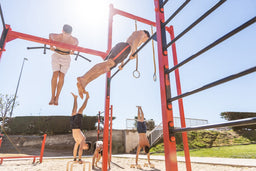
How to be fit over 40
How to be fit over 40
Hit the 40 milestone? Forget calories and reps – here are the health factors that really matter.
40 might be the “new 30. But it’s still a big milestone. 40 these days looks a lot different to a generation ago. We’re more active, looking after ourselves better, and we have different expectations of what 40 feels like.
How can we be fit after 40? The obvious answer might be “diet and exercise”. But we’d like to explore a different angle on 40+ health and fitness. Here are the health markers to keep in mind once you hit 40.
Waist measurement
Your waist measurement is one of the most reliable ways to track healthy body size and composition, and to catch increased visceral fat levels. Guidelines suggest men should aim for max 94cm (37in) waist circumference, and women max 80cm (31.5in).
Goal: get the tape measure out and decide if you need to make lifestyle changes
CV health
How fit are you really? We’re not talking about the fitness you’ve honed through years of gym workouts or sport. We mean true day-to-day fitness. Get out of your comfort zone and climb a big flight of stairs, heft some heavy stuff around, and spend half a day clearing the garden.
Goal: be fit and strong enough to enjoy an active lifestyle
Muscle mass
We all know BMI isn’t a great indicator of health, especially for people who train. But you do need to keep an eye on body composition. How much muscle mass do you have – and is it decreasing now you’ve hit 40? Take an honest look at your current muscle and body fat levels. It might be time to tinker with diet and training to avoid the dreaded slow slide.
Goal: to maintain or even gain muscle mass throughout your 40s
Eyes, ears and teeth
Sorry to say it, but things do start to fall apart a bit at this age. Do everything you can to maintain good general health, and catch things early. If you don’t go to the dentist regularly, now’s the time to start. If it’s been ages since you had a sight test, book one (and go for the OCT one where they test for glaucoma and macular degeneration). And it won’t hurt to get a hearing test, either.
Goal: book all those health appointments you’ve been putting off
Activity levels
How many hours per week do you spend being active? This doesn’t only mean workouts. Walking is just as relevant to health. Most of us find that figure declines from our 20s into our 30s and 40s. A sedentary lifestyle is a big risk factor in terms of heart health, stroke, type 2 diabetes, obesity and some cancers. Be intentional about stating active.
Goal: increase your weekly active hours by 10% (then add more if you can)
Drinking habits
Changes to food and drink habits can sneak up on you. Is it time to do an audit of your snack choices, takeaway orders, and alcohol use? The goal isn’t a radical overhaul, or to return to the habits you had when you were a carefree 20-something. Just aim to reduce the least healthy aspects of your food and drink behaviours.
Goal: less booze, more fruit and veg, see how you feel…
Blood pressure
Blood pressure measures the force that’s pressed against the walls of your arteries as your heart pumps blood. The top number (systolic) measures the pressure when your heart beats, and the bottom number (diastolic) measures the pressure between each beat. Average BP rises as we get older, but it’s still very important to keep an eye on yours. High blood pressure could indicate risk of heart disease, heart attack, or stroke. Take it seriously.
Goal: aim for max 124/77 for men and 122/74 for women. Data shows that BP tends to average slightly higher for Black people (average 127/73). Hypertension is defined as systolic pressure of 130+ or diastolic of 80+ most of the time. If you have any concerns, see a doctor ASAP.
4 risks factors for over 40s
Heart – our risk of cardiovascular disease, heart attack, stroke and aneurysm all increase at 40+ (sorry). It’s partly to do with physical changes, and partly to do with lifestyle factors. Prevention and vigilance are your best weapons.
Obesity – obesity itself isn’t a risk factor, but obesity-related diseases are. These include heart disease, type 2 diabetes, and some cancers plus issue with mobility and loss of activity. Stay a healthy weight and keep an eye on that waist measurement.
Stress – it’s unrealistic to tell people in their 40s to avoid stress. But it’s important that you manage it. Chronic stress can lead to overeating, poor sleep, depression, and a number of physical issues including heart attack. Reduce stress where you can.
Activity – many people see activity levels drop off in their 40s. We know you don’t fall into this category, but keep an eye on it anyway. Carve out that time for training, make the effort to go on more walks, suggest social stuff that involves being active.
The Gravity Fitness store has everything you need to stay active and enjoy training at every stage of life. Check out our range of functional fitness equipment.









































